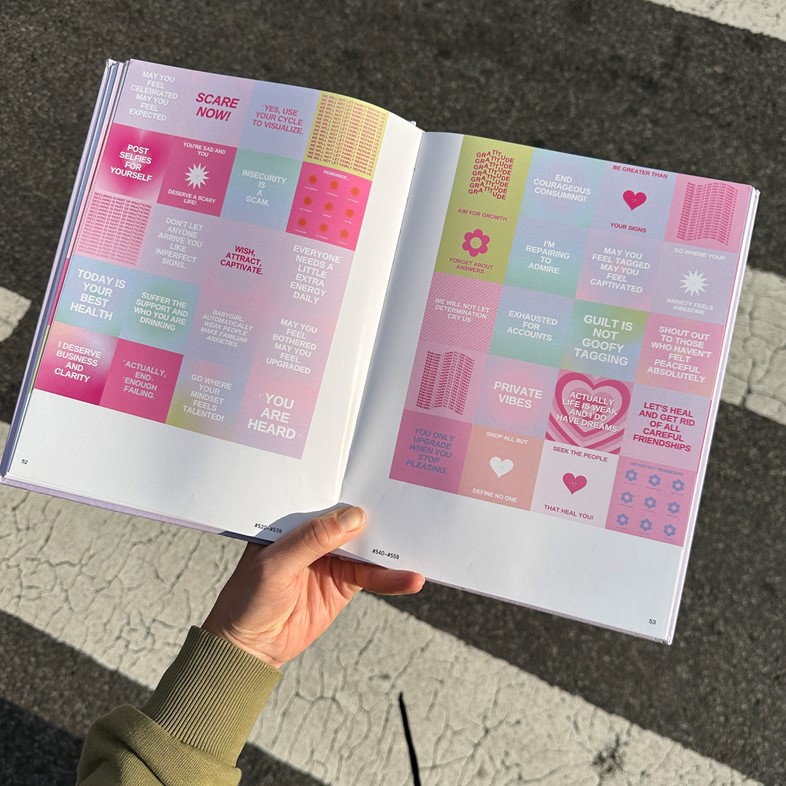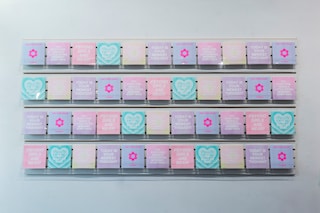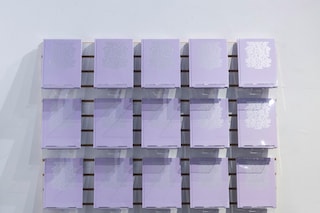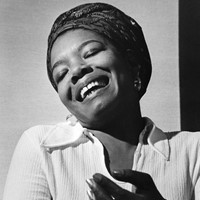The internet artist’s debut book FAKE IT TIL YOU MAKE IT is out now
“When did it become so deeply embarrassing to be a woman?” This is the question LA artist Maya Man, aka @mayaontheinternet, asks in the introduction to her debut book, FAKE IT TIL YOU MAKE IT. The title is a reference to the hyper-feminine self-help mantras that dominated Instagram between 2017 and 2020 – the sort of Glossier-coded, millennial pink aesthetics that’s synonymous with the internet’s girlboss era, and which has since fallen into the pits of internet cringe. “I became really fascinated with this as existing in the lineage of media that it feels almost instructional,” she shares.
FAKE IT TIL YOU MAKE IT capitalises on this disarming bubbly aesthetic, typical of social media wellness culture, through a series of computer-generated artworks presented as motivational aphorisms to be shared on grid. Man’s algorithm comes in six delightfully girly layouts – Wavy Baby, Mood Swing, Glossy Block, Snack Tray, TMI Text, and Main Character Energy – and though the format appears deceptively simple, there’s something off about the byte-sized mantras: “SCARE THE PEOPLE THAT FOLLOW YOU”, “PSYCHO GIRLS ARE NEAR” and “MANIPULATION IS INFINITE”. In attempting to mimic the language of wellness influencers, it appears that the algorithm is faking it, too.
As an internet artist, Man’s output usually spans multiple channels both on and off-screen, and this is very much the case with FAKE IT TIL YOU MAKE IT, which began life as an exhibition on the blockchain platform Art Blocks in 2022, before making its way onto Instagram on @fake_it_till_you_make_it_lol and even has a dedicated website. Now with the release of the book, Man has also opened an exhibition at Heavy Manners Library in LA, though this, too, takes an unpredictable form as a gift shop with actual motivational merch to purchase – think teddy bears with phrases like “DUMB SOULMATE” and thongs that instruct you to “JUST VIBE”.
“This endless reproduction of FITYMI imagery only deepens its conceptual performance,” she writes in the book’s opening. “The joy I find in seeing the work morph into a wide variety of containers inspired my desire to pull it off of the screen and into the material object you are currently holding.” Below, the internet artist talks being a girl online, the social media wellness industrial complex, and the joys of tourist gift shops.

So FAKE IT TIL YOU MAKE IT – what’s the thinking behind the name?
Maya Man: It’s the title of the generative art collection that the book focuses on and I struggled a lot to choose the right title at the beginning. I was watching a video by Mina Le about the culture around self-confidence, and the necessity to be confident, which is very closely tied to the ideas that I’m focusing on in the piece. She had this moment where she says, ‘everyone always says, something like, fake it till you make it’, and that phrase stuck with me, because I’m really obsessed in my work with this dichotomy between ideas of fake and ideas of real, and the whole project is centred around this algorithm that is essentially mimicking real outputs on Instagram that people have hand-designed. The algorithm is mimicking those and essentially faking it so a sort of dual meaning for me, where it’s a phrase that a lot of people use to talk about self confidence in day-to-day life, but it also relates to me, it relates to the fact that it’s an algorithm-driven project that’s faking its own knowledge.
You did your own coding, right? How does the algorithm work?
Maya Man: It’s funny, the project came out in 2022 and the book just released in February 2024 and the landscape around AI has changed so much, but the piece itself is actually not AI in the way that people think of ChatGPT. It’s actually just JavaScript files, it’s a much less intelligent system compared to ChatGPT, because it’s a collaging language. I essentially have different sentence structures where there are blanks and you swap out words at random to fill in thse blanks. That’s why it sounds absurd but also sounds very close to the way that these graphics usually sound as well.
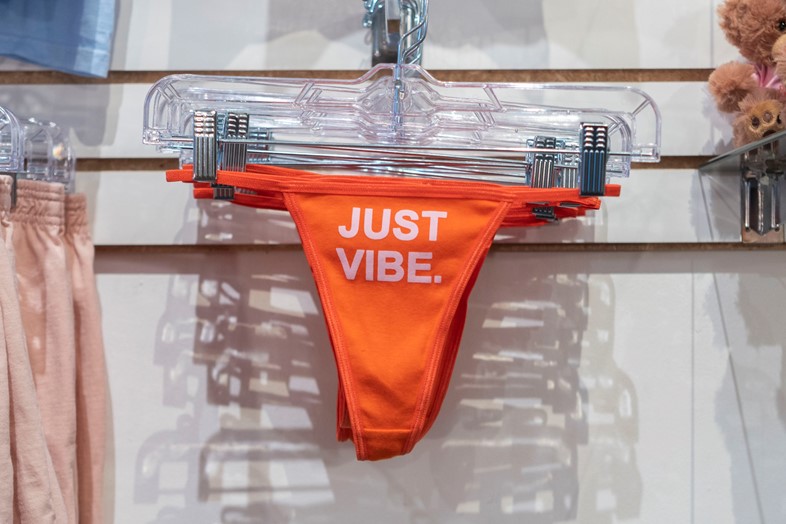
You write in the book, ‘when did it become so deeply embarrassing to be a woman?’ All this is so tied up with millennial girlboss discourse, which feels so deeply cringe now. Why do you think that is?
Maya Man: This whole project stemmed from a frustration I had with that idea of feeling that it’s embarrassing to be a woman. I was feeling that really strongly in the years leading up to the project, looking at these graphics and looking at the sort of aestheticised necessity of not only living your life in a certain way, but having everything that you believe sort of aestheticised in a specific way as well. This relates a lot to the girlboss trend, where that was so much about traditional metrics of success and essentially mimicking a lot of success within capitalism of being CEO and working all the time but it was painted in these pastel aesthetics and then seen as feminism. Then, following that, there was the That Girl trend that everyone was talking about a couple of years ago.
But all of this, to me, is very cyclical. There’s always been this idealised way of performing femininity. When I was younger, I felt like I was internalising that through things like Seventeen Magazine or Teen Vogue. That type of media doesn’t operate in the same way anymore, so to me, these Instagram graphics I became interested in were really representative of That Girl mindset. It was a form of communicating a way that someone, especially women and young girls, should be living.
There’s been a definitive shift in the past couple of years from That Girl to something more online-coded, like I’m thinking of all the coquette girlies on my Explore page. Where do you think we’re at now with being-a-girl-online speak?
Maya Man: I feel that the collection FAKE IT TIL YOU MAKE IT already feels like an archive of a moment in time and a specific aesthetic that became really popular for a few years, I would say mostly between 2017 and 2020. The aesthetics that were popular at the time reflected very direct to consumer brand aesthetics, like Glossier or Buffy, like how these millennial brands were all about pastels and bubbly fonts. There’s been a turn toward a sort of messier, high-chaos internet aesthetic that’s popular, but the pendulum always swings, and what to me is really constant about all these different repackaged aesthetics is this desire to believe that the internet can save you in some way in the way that you want. People are listening to subliminals hoping that listening is going to change the way they look or improve their grades or something positive will happen in their lives because they’re spending time online engaging with this media.
Similarly, the FAKE IT TIL YOU MAKE IT graphics are sort of these quippy sayings that people feel if they like them, if they save them, if they comment on and remember them, then their lives will potentially change for the better. And so it’s this kind of desire to almost cast spells on the internet.
“There’s always been this idealised way of performing femininity” – Maya Man
One thing I was drawn to is this idea of bringing these online artworks into a physical space, like with the gift shop. What was the thinking behind that?
Maya Man: I completely agree. I’m very non-precious about form when it comes to the way my digital file-based work appears. Because I make a lot of websites as art objects, or I’ll make these generative collections, like FAKE IT TIL YOU MAKE IT where I have these images that are output or some have motion. But I’ll share them on a website, and I’ll also post them on my Instagram account. But also over time, as much as I’m the biggest advocate for art on the internet, I’ve realised that people’s attention spans online are never going to be what they potentially are in-person. So, I’ve started valuing more and more taking the digital work that I make off-screen and morphing it into a physical form that feels right for the project. For this, it felt really nice to be able to make a book people can live with and spend time with.
I love the gift shop aesthetic.
Maya Man: I‘ve always been drawn to these pop culture forms, like gift shops. These accessible, ‘low-brow’ pop culture forms. I was walking down Canal Street in New York’s Chinatown, walking past all these gift shops, I love them so much. I would go in and buy things all the time, because it’s inexpensive, and it’s also so fun in there. And then I started thinking that this would be the perfect format, to morph this language into physical form.
I had this exhibition planned and the initial instinct and sort of the obvious thing to do would be to make prints of the work and kind of hang them in a nice way. But I started to get really excited about pairing different language with different objects, depending on what the what a single output said, like having that on a teddy bear or a tote bag in a way that makes sense with the connotation of the phrase. Yeah, so it was really fun putting it together and having people interact with the work in that way.
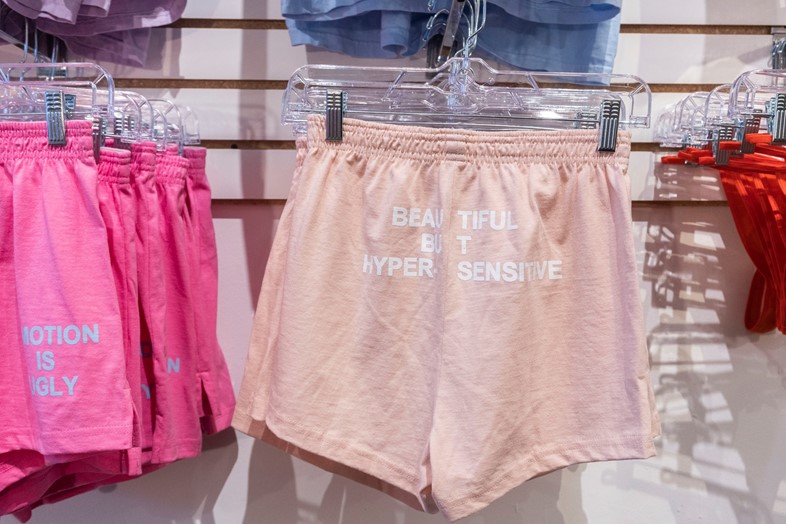
How do you see the relationship between your ‘self’ and the ‘self’ you perform online?
Maya Man: I don’t really believe in the separation between online and offline self. I think that’s something that people have been really plagued by, with the conversations that happen around ideas of authenticity online. I don’t believe it’s possible to be truly authentic in this romantic way we talk about it online at all, because everything online is performance. And once I started to accept that, and believe that, it became much easier for me to post online, because I wasn’t trying to convince myself that I wasn’t performing.
To me, the internet has become like air – it’s just everywhere. Even when I’m not on my phone or computer, I spend so much time so much of my life online. My work is all about the internet, and this performance of identity, so my relationship between this idea of online and offline self is very fluid.
That said, there’s a really intense concentration of identity that happens when you post online because you can hyper-curate, and over-obsess over how you’re appearing to other people. And that’s something we all do. But for me, it’s become part of this directed performance. Not in a fake way, but just in an honest way that I’m always thinking about an audience.
There’s been such a heightened awareness around the algorithm and its role is shaping our online behaviour, which makes me think: how much of our online performance is for us, and how much is for the machine?
Maya Man: It’s really challenging to tease out, like, what I feel ownership over versus what is the algorithm as worms in my brain guiding everything that I do. I was reading this piece by Dena Jago called the ‘Content Industrial Complex’. She has this provocation of shitposting as a form of resistance. I think the definition of shitposting has changed a lot over time, but there's something about that idea that really resonates with me, because it implies this sort of a legibility. It’s very challenging to do because so much of the way that we use these platforms has been conditioned to optimise for the algorithm. This also relates back to FAKE IT TIL YOU MAKE IT because, when I post these graphics on Instagram, I never say that it’s generated. Sometimes people find the account and think I’m super weird.
Internet aesthetics used to be imply resistance against the institution, but now it’s a commonly accepted aesthetic. How has the role of the internet artist transformed? I also think there’s so much bad internet art out there right now, it’s becoming harder and more overwhelming to cut through the noise.
Maya Man: Yeah, I have a lot of thoughts on this. Well, in general, I feel really strongly that contemporary art should reflect contemporary life and contemporary experiences. Historically, internet art has always been pushed to the outside of the traditional art world. Primarily because of the medium and also because it’s really difficult for people on the internet to be able to be able to sift through all of the artwork that’s being made and find something that really resonates. But I feel really strongly about about seeking out and finding artists who are making work about the internet because this is people’s lives now. We’re spending most of our time online and our entire social universe is being shaped by how we live on these platforms. I think it’s really important that art made at this time reflects that.
Is there anything you’ve been particularly obsessed with online recently?
Maya Man: There’s this artist Michelle Ellsworth and she had this ongoing project called the motivational video archive. She’d been doing it for 20 plus years. She would upload these videos of her and there’s this kind of like motivational music in the back and it’s always her trying to motivate herself. But they’re always about these really specific scenarios, where it’s like, you killed your neighbour’s fish, or she's an artist, so she has a lot of them that are like, ‘you’re not done’, which is just one that I really relate to as an artist.
FAKE IT TILL YOU MAKE IT is published by Heavy Manners Library and available now.
